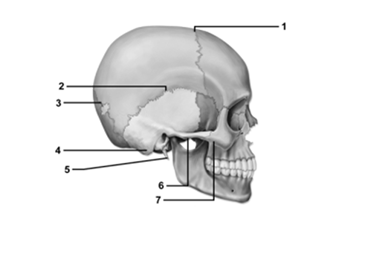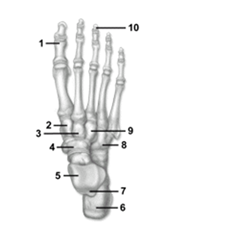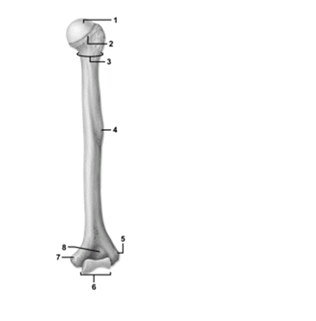A) forms at the proximal end of each limb bud.
B) plays a role in differentiation and elongation of the limb.
C) ossifies prior to formation of the hand and foot plates.
D) must undergo apoptosis before the limb can develop.
E) secretes mesoderm for muscle formation.
G) C) and E)
Correct Answer

verified
Correct Answer
verified
Multiple Choice
The tibial tuberosity is the attachment site for the
A) patellar ligament.
B) hamstring muscles.
C) patellar tendon.
D) sciatic nerve.
E) intercondylar eminence.
G) B) and D)
Correct Answer

verified
Correct Answer
verified
Multiple Choice
The _________ provide passageways for spinal nerves to exit the vertebral column and travel to other parts of the body.
A) vertebral foramina
B) intervertebral foramina
C) vertebral canals
D) articular facets
E) transverse foramina
G) A) and B)
Correct Answer

verified
Correct Answer
verified
Multiple Choice
Which feature is unique to the axis
A) Dens
B) Bifid spinous process
C) Superior articular facet
D) Transverse foramen
E) Vertebral foramen
G) B) and D)
Correct Answer

verified
Correct Answer
verified
Multiple Choice
Which is not characteristic of a male pelvis
A) Greater sciatic notch narrow,U-shaped,and deep
B) Coccyx tilted posteriorly
C) Pubic arch less than 90 degrees
D) Obturator foramen oval
E) Superior inlet heart-shaped
G) All of the above
Correct Answer

verified
Correct Answer
verified
True/False
Sutural bones are most commonly found in the squamous suture.
B) False
Correct Answer

verified
Correct Answer
verified
True/False
When the radius and ulna are parallel with one another,the forearm is said to be in pronation.
B) False
Correct Answer

verified
Correct Answer
verified
Multiple Choice
 -This figure shows a lateral view of the skull.Which number indicates the styloid process
-This figure shows a lateral view of the skull.Which number indicates the styloid process
A) 4
B) 5
C) 6
D) 7
E) The styloid process is not shown on this figure.
G) B) and C)
Correct Answer

verified
Correct Answer
verified
Multiple Choice
What is the function of the nuchal lines
A) Attachment for dura mater
B) Attachment for muscles and ligaments
C) Passageway for cranial nerves
D) Passageway for jugular vein
E) Grooves for dural sinuses
G) A) and C)
Correct Answer

verified
Correct Answer
verified
Multiple Choice
The incisive foramen and palatine process are features of which bone
A) Mandible
B) Palatine bone
C) Vomer
D) Maxilla
E) Temporal bone
G) A) and E)
Correct Answer

verified
Correct Answer
verified
Multiple Choice
On the os coxae,the ischial ramus is fused to the
A) inferior pubic ramus.
B) superior pubic ramus.
C) ischial spine.
D) ischial body.
E) pubic tubercle.
G) A) and E)
Correct Answer

verified
Correct Answer
verified
Multiple Choice
What is the correct order for the vertebral regions,from superior to inferior
A) Cervical - thoracic - sacral - coccygeal - lumbar
B) Thoracic - sacral - lumbar - thoracic - coccygeal
C) Cervical - thoracic - lumbar - sacral - coccygeal
D) Thoracic - coccygeal - cervical - lumbar - sacral
E) Thoracic - cervical - lumbar - coccygeal - sacral
G) A) and B)
Correct Answer

verified
Correct Answer
verified
Multiple Choice
 -This figure shows the bones of the ankle and foot.The bone indicated by number 4 is the
-This figure shows the bones of the ankle and foot.The bone indicated by number 4 is the
A) lateral cuneiform.
B) intermediate cuneiform.
C) navicular.
D) medial cuneiform.
E) talus.
G) A) and E)
Correct Answer

verified
Correct Answer
verified
Multiple Choice
 -This figure shows the humerus.What is the feature indicated by number 3
-This figure shows the humerus.What is the feature indicated by number 3
A) Surgical neck
B) Anatomical neck
C) Greater tubercle
D) Lesser tubercle
E) Deltoid tuberosity
G) A) and B)
Correct Answer

verified
Correct Answer
verified
Multiple Choice
What is the location of the auditory ossicles
A) Petrous part of temporal bone
B) Squamous part of temporal bone
C) Tympanic part of temporal bone
D) Auditory part of temporal bone
E) Mastoid part of temporal bone
G) A) and C)
Correct Answer

verified
Correct Answer
verified
Multiple Choice
The basin in the floor of the cranium that accommodates the temporal lobe of the brain is the
A) posterior cranial fossa.
B) middle cranial fossa.
C) inferior cortical plate.
D) cribriform fissure.
E) sella turcica.
G) B) and E)
Correct Answer

verified
Correct Answer
verified
Multiple Choice
The skull consists of _____ cranial bones and _____ facial bones.
A) 8,14
B) 7,12
C) 10,12
D) 5,7
E) 9,11
G) C) and E)
Correct Answer

verified
Correct Answer
verified
Multiple Choice
The only direct connection between the pectoral girdle and the axial skeleton is where the _____ articulates with the _____.
A) humerus;scapula
B) scapula;clavicle
C) scapula;thoracic cage
D) clavicle;humerus
E) clavicle;sternum
G) A) and C)
Correct Answer

verified
Correct Answer
verified
Multiple Choice
The inferior termination of the sacral canal is an opening called the
A) anterior sacral foramen.
B) sacral promontory.
C) posterior sacral foramen.
D) sacral hiatus.
F) A) and D)
Correct Answer

verified
Correct Answer
verified
Multiple Choice
Protection of vital organs and hematopoiesis are two functions commonly named for the __________ skeleton.
A) axial
B) appendicular
D) undefined
Correct Answer

verified
Correct Answer
verified
Showing 101 - 120 of 194
Related Exams